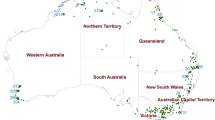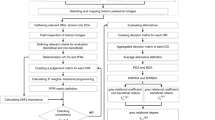Abstract
The purpose of this study was to develop a computing system (CS) with fuzzy membership and graph connectivity approach to estimate the predictability of thunderstorms during the pre-monsoon season (April–May) over Kolkata (22°32′N, 88°20′E), India. The stability indices are taken to form the inputs of the CS. Ten important stability indices are selected to prepare the input of the fuzzy set. The data analysis during the period from 1997 to 2006 led to identify the ranges of the stability indices through membership function for preparing the fuzzy inputs. The possibility of thunderstorms with the given ranges of the stability indices is validated with the bipartite graph connectivity method. The bipartite graphs are prepared with two sets of vertices, one set for three membership functions (strong, moderate and weak) with the stability indices and the other set includes the three membership functions for the probability of thunderstorms (high, medium and low). The percentages of degree of vertex (ΔG) are computed from a sample set of bipartite graph on thunderstorm days and are assigned as the measure of the likelihood of thunderstorms. The results obtained from graph connectivity analysis are found to be in conformity with the output of fuzzy interface system (FIS). The result reveals that the skill of graph connectivity is better and supports the FIS in estimating the predictability of thunderstorms over Kolkata during the pre-monsoon season. The result further reveals from the minimum degree of vertex connectivity that among the ten selected stability indices, only four indices: lifted index, bulk Richardson number, Boyden index and convective available potential energy, are most relevant for estimating the predictability of thunderstorms over Kolkata, India.















Similar content being viewed by others
References
Abraham A, Philip NS, Joseph B (2001) Will we have a wet summer? Long term rain forecasting using soft computing models. In: Kerchoffs EJH SnorekM (ed) Modeling and simulation 2001, publication of the society for computer simulation international. Czech Republic, Prague, pp 1044–1048
Anderson T, Anderson M, Jacobson C, Nilsson S (1989) Thermodynamic indices for forecasting thunderstorms in southern Sweden. Meteorol Mag 118:141–146
Anthes RA (1976) Numerical prediction of severe storms—certainty, probability, or dream. Bull Amer Met Soc 57:423–430
Basak P, Sarkar D and Mukhopadhyay AK (2012) Estimation of thunderstorm days from the radio-sonde observations at Kolkata (22.53oN, 88.33oE), India during pre-monsoon season: an ANN based approach earth science India, eISSN: 0974–8350 Vol. 5 (IV), October, 2012, pp. 139–151
Bluestein HB, Parker SS (1993) Modes of isolated, severe convective storm formation along the dryline. Mon Wea Rev 121:1354–1372
Chaudhuri S (2005) Genetic algorithm to recognize apt energy for the genesis of severe thunderstorms. Vatabaran AFAC J Meteorol 29(2):1–8
Chaudhuri S (2006a) Predictability of chaos inherent in the occurrence of severe thunderstorms. Adv Complex Sys 9:1–9
Chaudhuri S (2006b) A hybrid model to estimate the depth of potential convective instability during severe thunderstorms. Soft Comput 10:243–248
Chaudhuri S (2007) Chaotic graph theory approach for identification of convective available potential energy (CAPE) patterns required for the genesis of severe thunderstorm. Adv Complex Sys 10:413–422
Chaudhuri S (2008a) Identification of the level of downdraft formation during severe thunderstorms: a frequency domain analysis. Meteorol Atmos Phys 102:123–129
Chaudhuri S (2008b) Preferred type of cloud in the genesis of severe thunderstorms—a soft computing approach. Atmos Res 88:149–156
Chaudhuri S (2010) Convective energies in forecasting severe thunderstorms with one hidden layer neural net and variable learning rate back propagation algorithm. Asia-Pacific. J Atmos Sci 46(2):173–183
Chaudhuri S (2011) Implementation of intuitionistic fuzzy logic to assess the predictability of severe thunderstorms. Asia-Pacific J Atmos Sci 47(5):477–483
Chaudhuri S, Das D and Middey A An investigation on the predictability of thunderstorms over Kolkata, India using fuzzy inference system and graph connectivity” (present study)
Chaudhuri S, Middey A (2009) Applicability of bipartite graph model for thunderstorms forecast over Kolkata. Adv Meteorol 2009:1–12
Chaudhuri S, Middey A (2011a) Nowcasting thunderstorms with graph spectral distance and entropy estimation. Meteorol Appl 18(2):238–249
Chaudhuri S, Middey A (2011b) Adaptive neuro-fuzzy inference system to forecast peak gust speed during thunderstorms. Meteorol Atmos Phys 14:139–149
Chaudhuri S, Middey A (2012) Disparity in the characteristic of thunderstorms and associated lightning activities over dissimilar terrains. Meteorol Atmos Phys 119(3–4):151–161
Chaudhuri S, Middey A (2013) Comparison of tropical and midlatitude thunderstorm characteristics anchored in thermodynamic and dynamic aspects. Asia-Pacific J Atmos Sci doi: 10.1007/s13143-014-0006-9
Chaudhuri S, Pal J, Middey A and Goswami S (2013) Nowcasting Bordoichila with a composite stability index. Natural Hazards (Springer), 66, 2, 591–607 (IF:1.529)
Chaudhuri S, Goswami S and Middey A (2014) Morphological classification pertaining to validate the climatology and category of thunderstorms over Kolkata, India theoretical and applied climatology (Springer), 116, 1–2, 61–74
Chung F (1992) Spectral graph theory. CBMS Regional Conference Series in Mathematics 92. American Mathematical Society, Providence RI
Comric AC (1997) Comparing neural networks and regression models for ozone forecasting. J Air Waste Manag As 47:653–663
Dance S, Ebert E, Scurrah D (2010) Thunderstorm strike probability nowcasting. J Atmos Oceanic Technol 27:79–93
Diestel R (2005) Graph theory. Springer, New York
Djuric D (1994) Weather analysis ISBN-10: 0135011493|ISBN-13: 9780135011492
Doswell CA (1987) The distinction between large-scale and mesoscale contribution to severe convection: a case study example. Weather Forecast 2:3–16
El-Ghoul M (2002) The most general set and chaos graph, chaos. Solitons Fractals UK 18:833–838
Huntrieser H, Schiesser HH, Schmid W, Waldvogel A (1997) Comparison of traditional and newly developed thunderstorm indices for Switzerland. Weather Forecast 12:108–125
Jacovides CP, Yonetani T (1990) An evaluation of stability indices for thunderstorm prediction in greater Cyprus. Weather Forecast 5(4):559–569
Lakshmanan V, Witt A (1997) A fuzzy logic approach to detecting severe updrafts, A.I. Applications 11:1–12
Lee RR, Passner JE (1993) The development and verification of TIPS: an expert system to forecast thunderstorm occurrence. Weather Forecast 8:271–280
Lilly DK (1990) Numerical prediction of thunderstorms—has its time come? Quart J Roy Meteorol Soc 116:779–798
Lin Pin-Fang, Chang Pao-Liang, Jou Ben Jong-Dao, Wilson James W, Roberts Rita D (2012) Objective prediction of warm season afternoon thunderstorms in Northern Taiwan using a fuzzy logic approach. Weather Forecast 27:1178–1197
Litta AJ, Mary Idicula S and Mohanty UC (2013) Artificial neural network model in prediction of meteorological parameters during pre monsoon thunderstorms international journal of atmospheric sciences, 2013 (2013), Article ID 525383, 14 page http://dx.doi.org/10.1155/2013/525383MAE 19.61
Lorenz EN (1963) Deterministic nonperiodic flow. J Atmos Sci 20:130–141
Lorenz EN (1969) Three approaches to atmospheric predictability. Bull Amer Meteorol Soc 50:345–351
Marzban C, Witt A (2001) A Bayesian neural network for severe-hail size prediction. Weather Forecast 16(5):600–610
Mull S, Rao YP (1950) On the origin of down draughts in a thunder-storm. Indian J Meteorol Geophys 1:171
Murtha J (1995) Applications of fuzzy logic in operational meteorology. Scientific Services and Professional Development Newsletter, Canadian Forces Weather Service, pp 42–54
Neumann CJ (1971) The thunderstorm forecasting system at the Kennedy Space Center. J Appl Meteorol 10:921–936
Orlanski I (1975) A rational subdivision of scales for atmospheric processes. Bull Am Meteorol Soc 56(5):527–530
Pokrovsky OM, Kwok RHF, Ng CN (2002) Fuzzy logic approach for description of meteorological impacts on urban air pollution species: a Hong Kong case study. Comput Geosci 28(1):119–127
Rasmussen EN, Blanchard DO (1998) A baseline climatology of sounding-derived supercell and tornado forecast parameters. Weather Forecast 13:1148–1164
Reap RM, Foster DS (1979) Automated 12–36 hour probability forecasts of thunderstorms and severe local storms. J Appl Meteorol 18:1304–1315
Schultz P (1989) Relationship of several stability indices to convective weather events in Northest Colorado. Weather Forecast 4:73–80
Stone HM (1985) A comparison among various thermodynamic parameters for the prediction of convective activity, Part I, NOAA Technical Memorandum, NWS-ER 68, Washington DC
Acknowledgments
The authors acknowledge India Meteorological Department (IMD) for making data/records available for the present research. The authors thank the anonymous reviewers for their valuable comments and suggestion which helped to improve the clarity of the paper.
Author information
Authors and Affiliations
Corresponding author
Rights and permissions
About this article
Cite this article
Chaudhuri, S., Das, D. & Middey, A. An investigation on the predictability of thunderstorms over Kolkata, India using fuzzy inference system and graph connectivity. Nat Hazards 76, 63–81 (2015). https://doi.org/10.1007/s11069-014-1477-9
Received:
Accepted:
Published:
Issue Date:
DOI: https://doi.org/10.1007/s11069-014-1477-9




